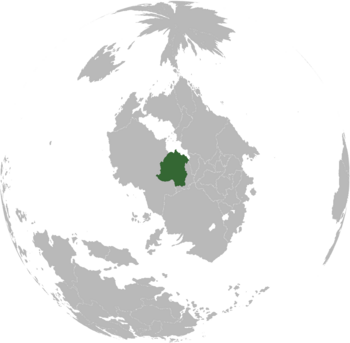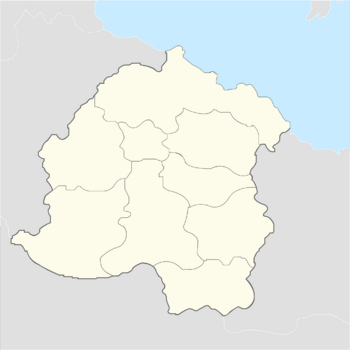Yonderre
Most Serene Grand Duchy Yonderre | |
|---|---|
Motto: Nam Claritas Dei For the Glory of God | |
Anthem: Yonderre, notre terre (Burgoignesc) Yonderre, unser Land (Gothic) (Julian Ænglish: Yonderre, our land) | |
 Yonderre within Levantia | |
 Mainland Yonderre divided in nine counties | |
| Capital and largest city | Collinebourg |
| Official languages | Burgoignesc Gothic |
| Religion | Catholic Church |
| Demonym(s) | Yonderian Yond |
| Government | Federal parliamentary elective constitutional monarchy |
| Auguste IV de Somua | |
| Bertelis Arcaneaux | |
| Legislature | Yonderian Parliament |
| Establishment | |
| 1458 | |
| 1494 | |
| Area | |
• Total | 1,261,724 km2 (487,154 sq mi) |
| Population | |
• 2024 estimate | 100,235,660 |
• Density | 79.4/km2 (205.6/sq mi) |
| GDP (nominal) | 2024 estimate |
• Total | $6,043,096,577,723.48 |
• Per capita | $60,288.89 |
| Currency | Taler (₮) |
| Date format | dd-mm-yy |
| Driving side | right |
| Calling code | +216 |
| Internet TLD | .yon |
Yonderre, officially styled as the Most Serene Grand Duchy Yonderre (Burgoignesc: Sérénissime Grand-Duché Yonderre, Gothic: Serenistische Großherzogtum Yonderre), is a nation in Levantia. Its capital and most populous city is Collinebourg. Yonderre consists of nine Counties that are divided into 72 Baronies, each of which further subdivides into munincipalities. The Kestrel Isles of the Vandarch Archipelago form a seperate Grand Barony directly under the Grand Duke of Yonderre. Yonderre neighbours Faneria across the Vandarch to the north via the Kestrel Isles, Hollona and Diorisia to the east, Anglei to the southeast, Carna to the southwest and Eldmora to the west. Yonderre is a semi-landlocked country on the Vandarch south coast, having access to the Kilikas Sea via the Grand Vandarch Canal which is administered by the Marine Yonderre.
Yonderre has been inhabited since at least 10,000 BC by proto-Gothic and Khovihnihk tribes. The Bronze and Iron Ages were characterised by extensive contacts with other cultures in Catholic Levantia and Ultmar. Known as East Gothica to Great Levantia, Yonderre became a crossroads of trade between Catholic Levantia and Ultmar around the late Bronze Age. The Great Gothic Migration which happened around the fall of the Levantine Potentate in the late 6th century AD drove the Khovihnihk tribes out of East Gothica in a matter of decades, afterwhich several attempts to form a centralized Gothic nation failed. The resultant wealth of independent or semi-independent Gothic nations coexisted mostly peacefully with its foreign neighbours albeit in a near constant state of internal turmoil until the latter half of the 15th century saw East Gothica conquered by crusaders from the Holy Levantine Empire, establishing Yonderre as an autonomous marcher realm under Joanus de Martigueux. Yonderre's legitimacy was solidified by the Treaty for the guarantee of Joanus' Land signed with the Holy Levantine Empire in 1494.
Despite a largely succesful transition from the East Gothic faith to Catholicism, settlers from the Holy Levantine Empire raised ethnic and cultural tensions throughout the late fifteenth and sixteenth centuries. The chiefly Bergendii settlers established new villages or became wealthy burghers in the new cities settled by the crusaders, while the indigenous Gothic population were entrenched in serfdom under their new Levantine Catholic nobility. Following a number of smaller uprisings, this ultimately concluded in the First Potato War (1556-1557) and the Yonderian Peasants' War of the mid-1640s, widespread uprisings throughout Yonderre both of which ultimately failed. Yonderre was the main combatant of the Likedealers during the Golden Age of Vandarch Piracy in the late 18th century, policing the south Vandarch. Yonderre had its final civil war, the Second Potato War, between 1787-1788, which resulted in relaxed taxation and granted more rights to the peasantry. Yonderre prospered throughout the 19th century in what is known as the Yonderian Golden Age, a time of exceptional creative production in the fields of culture and science. Yonderre persued a strict policy of neutrality throughout the Great War, although more than 1.5 million Yonderians served in the Burgoignesc Foreign Legion as volunteers. Yonderre joined the Levantia and Odoneru Treaty Association in the aftermath of the Great War and the Yonderian Defence Force has partaken in numerous peacekeeping operations around the world since then, notably Operation Khyzer Rhykh and the Deluge.
Yonderre is a middle power with a strong economy, having the world's second-largest economy by GDP per capita. A highly developed country, Yonderians enjoy a high standard of living and the country offers social security and a universal health care system, environmental protections, and a tuition-free university education. Yonderre ranks highly in most metrics of national performance, including education, health care, protection of civil liberties, democratic governance and gender equality. Yonderian cuisine is famous worldwide, particularly for its pastries. Yonderre is a member of the Levantine Union and the Talerzone and was a member of the Levantia and Odoneru Treaty Association from 1958 until its dissolution and replacement in 2018 by the Levantine Union Defense Council, of which Yonderre is a founding member.
Etymology and title
Yonderre takes its name from the Treaty for the guarantee of Joanus' Land wherein the lands making up Yonderre are mentioned as Joanusterra, "Joanus' land" from Latin Terra, in reference to Joanus de Martigueux, the first Crusader Grand Count of Yonderre. The styling of the name was changed over time, with the more Burgoignesc-sounding Yoansterre appearing side-by-side with Joanusterra throughout the sixteenth century. The present spelling of the name is first documented in the early seventeenth century and is thought to have replaced the others almost entirely by time of the Yonderian Peasants' War in the 1640s. Yonderre has sometimes historically been referred to as Jondaar and Jonderd in the East Gothic language after the Conquest of Joanusterre, although this name has amost entirely fallen out of use in favour of the official style.
The title of Most Serene Grand Duchy was conferred on Yonderre by Pope Gregory XIII in 1574 following lengthy negotiations. The Yonderian nobility had wanted the nation raised to the status of a Kingdom but due to stipulations in the Treaty for the guarantee of Joanus' Land, Yonderre could not be made a Kingdom as it belonged to the Crown of the Holy Levantine Empire de jure, despite the treaty having made Yonderre de jure autonmous and de facto independent in 1494.
Administrative regions
This article is a work-in-progress because it is incomplete and pending further input from an author. Note: The contents of this article are not considered canonical and may be inaccurate. Please comment on this article's talk page to share your input, comments and questions. |
| Name | Capital | Population | Coat of Arms | Location |
|---|---|---|---|---|
| County of Amarre | Toubourg | 10,840,697 | ||
| County of Collinebourg | Collinebourg | 12,204,216 | 66px | |
| County of Donne | Donnebourg | 11,952,430 | 66px | |
| County of Kubagne | Sainte-Catherine | 11,430,226 | ||
| County of Moncheval | Nouvelle-Vilauristre | 4,925,941 | 66px | |
| County of Montgebirre | Sainte-Jule-du-Mont | 4,320,501 | 66px | |
| County of Somua | Vallonbourg | 7,903,235 | 66px | |
| County of Vandarcôte | Gabion | 20,402,143 | ||
| County of Vollardie | Willing | 9,850,322 | ||
| Grand Barony of Kestrel Isles | Falcsbourg | 736,871 |

